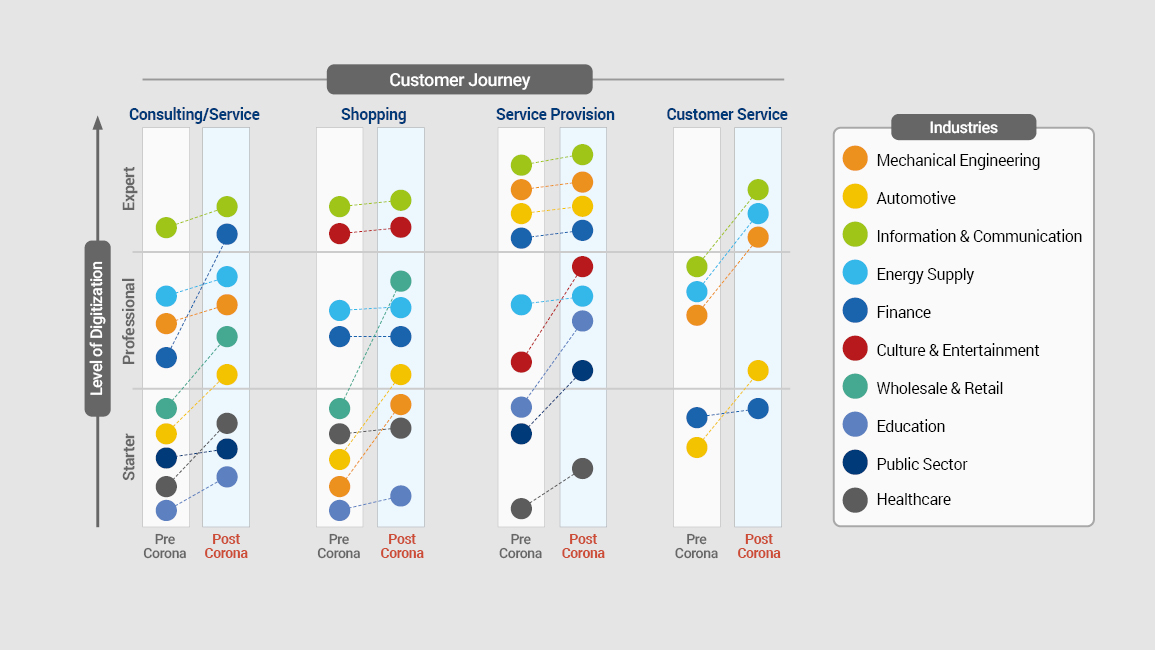These remain challenging times for companies and organizations - even if the social distancing to contain the Covid 19 pandemic is now somewhat relaxed, we are all in search of a "new normal". If you take a look back at the last few weeks, it is quite impressive what has been and is being implemented to cope with the situation. Customer needs have been met digitally in an astonishingly short time, and technologies that were previously rather stagnant are now being used intensively. My colleague Johannes Pfeffer and I firmly believe that this development push will bring companies and organizations forward and that many often innovative changes will not disappear again!
Along a general Customer Journey, we have identified four customer needs in particular for which digital solutions are just being found across many industries, leading to more flexible and resilient business models.
Consulting and customer service
In our view, there is currently the most movement at the beginning of the customer journey (see figure below). Even if physical customer communication and service channels are currently limited, customers still want to be served. Innovative examples of this can be found in all industries. We have selected a few:
To protect its in-store employees from contagion and to relieve them, an EDEKA store manager near Hamburg now relies on customer advice from "Pepper," a small humanoid robot. The British department store chain John Lewis & Partners provides its customers with free video advice on interior design for living rooms, children's rooms or kitchens, and fashion styling. The service staff, who usually provide advice in the department store, use the video consultation to get a picture of the individual situation and then send the customer personalized product suggestions digitally after the meeting.
Similar consulting services via video conferencing are now available, for example, in the area of continuing education, as implemented by the IHK Akademie Schwaben (Swabian Chamber of Industry and Commerce), and bank customers can also clarify many questions via video conferencing. Video ID procedures, which are offered by Commerzbank and the online bank N26, for example, are also exciting. These make it possible to verify oneself digitally in order to open an account.
The examples show that not only is digitalization taking place, but new added value is also being created for customers (better advice through knowledge of local conditions, acceleration of a previously time-consuming postal process, etc.). Have you optimally positioned your service channels to stay in close contact with customers and retain them?
Shopping
Personal shopping will certainly remain restricted for some time to come. Even if the stores slowly open again, protective masks still restrict us and for risk groups shopping is not without danger. So it's no surprise that alternatives are booming.
Online grocery shopping or online pharmacies have been around for quite some time, but until now these offerings were only moderately in demand. Now demand is so high that interested parties have to use a live ticker on their smartphone to find out when delivery capacities become available.
Brand-name manufacturers, who have so far relied almost exclusively on face-to-face sales, are also responding. Here, the aim is to create virtually impressive shopping experiences. The Fiat Chrysler Automobiles (FCA) group, for example, is now also presenting its model range in digital showrooms with virtual animations, information videos and online purchase advice. Electric car pioneer Tesla has been demonstrating for several years now how car manufacturers can even rely entirely on online sales. It remains to be seen whether these developments will also be adopted by traditional manufacturers due to the Corona crisis.
The B2B sector is also increasingly relying on digital purchasing: the digital platform Xometry, for example, brings together clients and certified producers for CNC and sheet metal processing or 3D printing orders. The platform is not currently experiencing any slumps. The order books of the connected producers remain full.
Service Provision
Of course, even before the outbreak of the pandemic, many services were provided digitally by companies and organizations. However, in order to be able to maintain service delivery even in times of social distance, digital formats can now be found in an astonishing number of areas where this was previously offered only sparsely or not at all.
The most impressive of these is certainly the change that schoolchildren and students have had to master for a few weeks now. Digital learning is no longer being ground up in the jurisdictional dispute between the federal and state governments, but is being implemented with a great deal of commitment from everyone involved.
But many leisure and entertainment activities, such as music lessons, art workshops, fitness classes, or concerts, are now also being conducted digitally. Berlin-based ArtNight for example, has radically digitized its business model and now offers online tutorials and an art kit with the necessary utensils instead of physical events in bars and restaurants. The Biewers Winery now offers digital wine tastings under the motto "each to his own and all together" via social media livestreams. While 80 people can take part in a traditional tasting in the vinotheque, more than 200 tasting packages worth between €45 and €80 were ordered in advance for the digital tasting.
Digital formats are also enjoying great popularity in the large area of continuing education - trade shows are taking place digitally and webinars are better attended than ever before - and are being developed further at full speed. With innovative tools such as nextmoderator, virtual conferences are emerging which enable digital co-creation in plenary sessions and in topic-specific breakouts, such as at Detecon's CIXX Think Thank 2020 (here is an exciting look at how this can look).
Even public administrations and the health care sector are currently working at full speed to be able to continue to provide their services. Numerous city and municipal administrations, including Berlin, Hamburg, Munich, and Cologne, are now offering their citizens some services and benefits online, such as applications for certificates of good conduct, building permits, vehicle registrations, license plates, and many other requests. In some cases, doctors' appointments can be made by video conference, and companies such as Jameda (platform for doctor's appointments ("shopping") and practice ratings), TeleClinic (telemedicine company) and Kinderheldin (online midwife consultation) are seeing enormous growth in demand for remote treatment.
Customer service - repair and maintenance
Even if something jams at home or on the machine at work, personal help on site is not always desired or possible.
The company iFixit, which operates a platform with numerous repair instructions and a spare parts exchange, has launched an online challenge under the motto "#FixAtHome" that encourages people to carry out repairs in their own homes. In addition, some communities are emerging that offer digital repair consultations, enabling virtual remote diagnoses. A consultation that previously would have taken place in a repair café, for example, now takes place via video conferencing. Wouldn't that also be an option for craftsmen to save travel time and offer services over a larger area?
Another option is digital remote maintenance. This is already possible in modern networked vehicles. In addition to developments in autonomous driving, there should also be a significant surge in development in this area. In the areas of information and communications technology, mechanical engineering and energy, this digital type of maintenance is also already available to a greater extent. In particular, remote preventive maintenance can ensure that major problems are eliminated at an early stage, thus avoiding downtime. With the increasing networking of objects, this type of customer service will grow even more in the future.
Ideas for your own business model discovered?
In summary, our chart illustrates the relevance of customer needs for the individual industries and shows our assessment of the digitization push. See if you would have assessed your industry in the same way!

From our point of view, in addition to the education sector, healthcare and public administration, it is particularly the retail and automotive industries that are currently finding innovative ways to adapt their business models. But no industry is spared the effects of the pandemic. We would be delighted if you have discovered one or two ideas for your business model. Or maybe you have some other innovative ideas you'd like to share and discuss with us?
Stay healthy and your company resilient!








